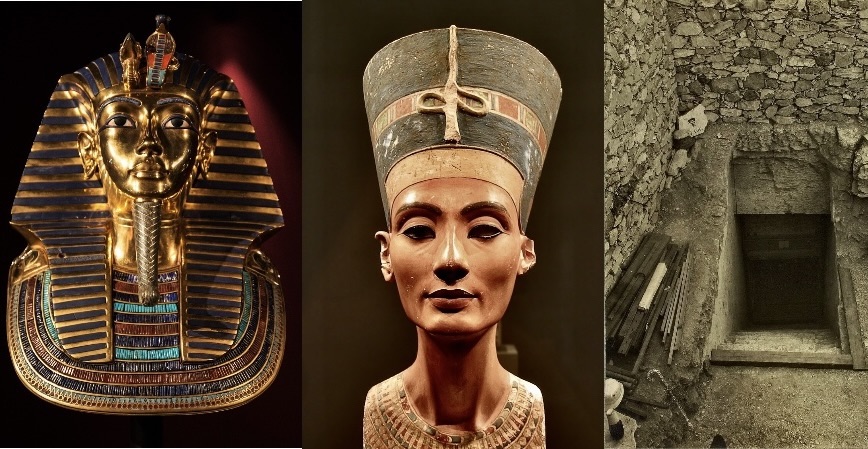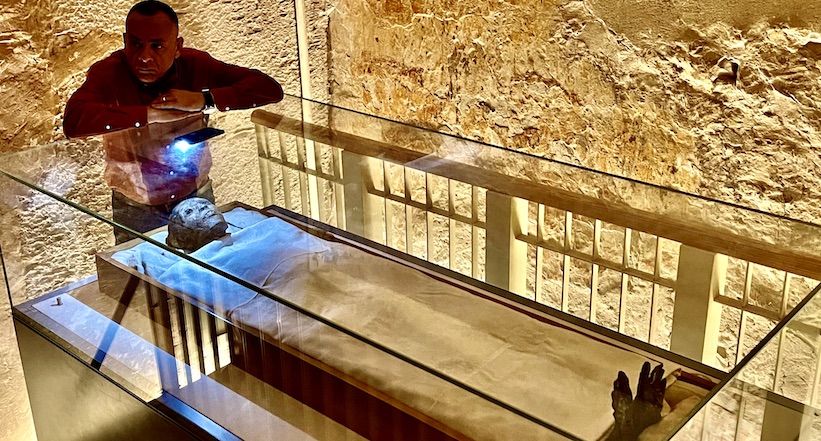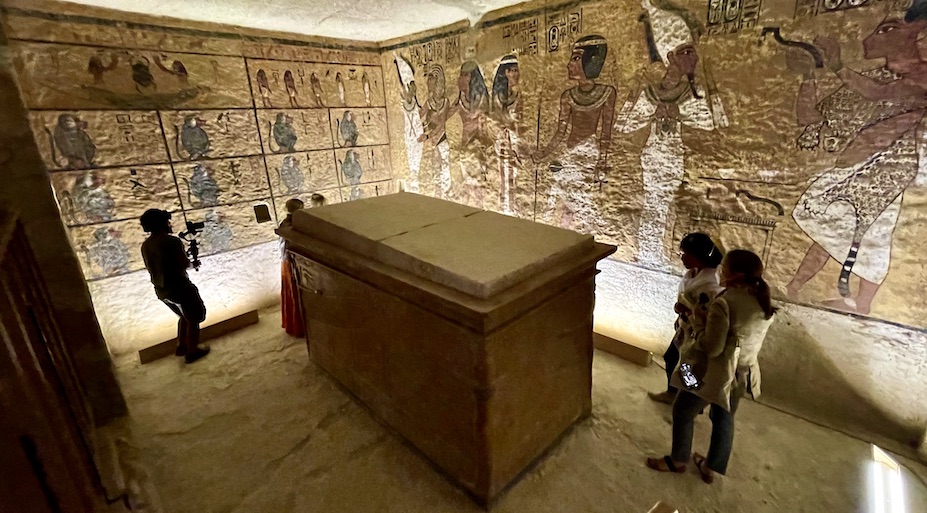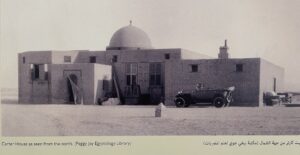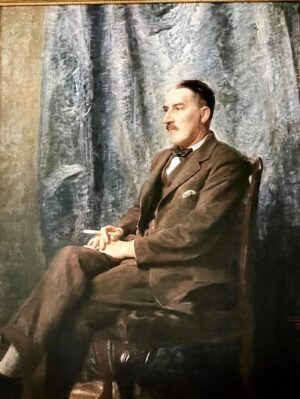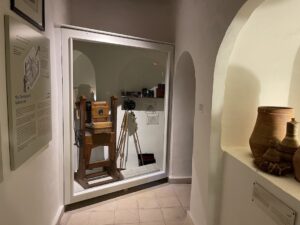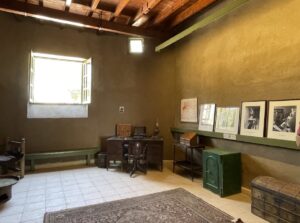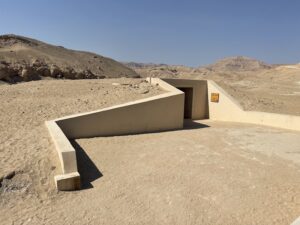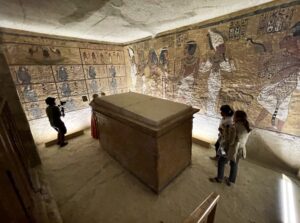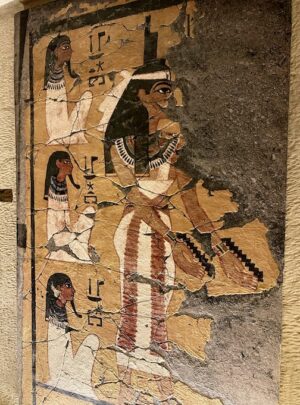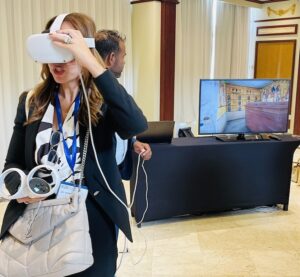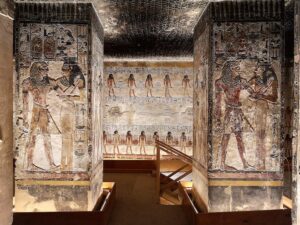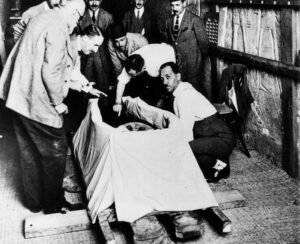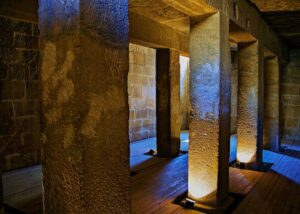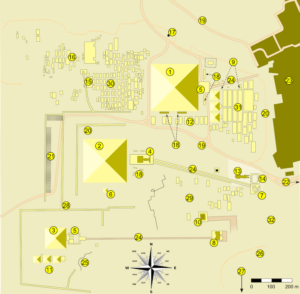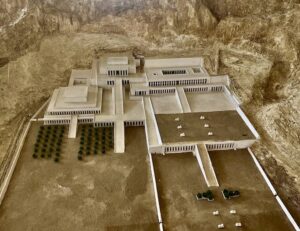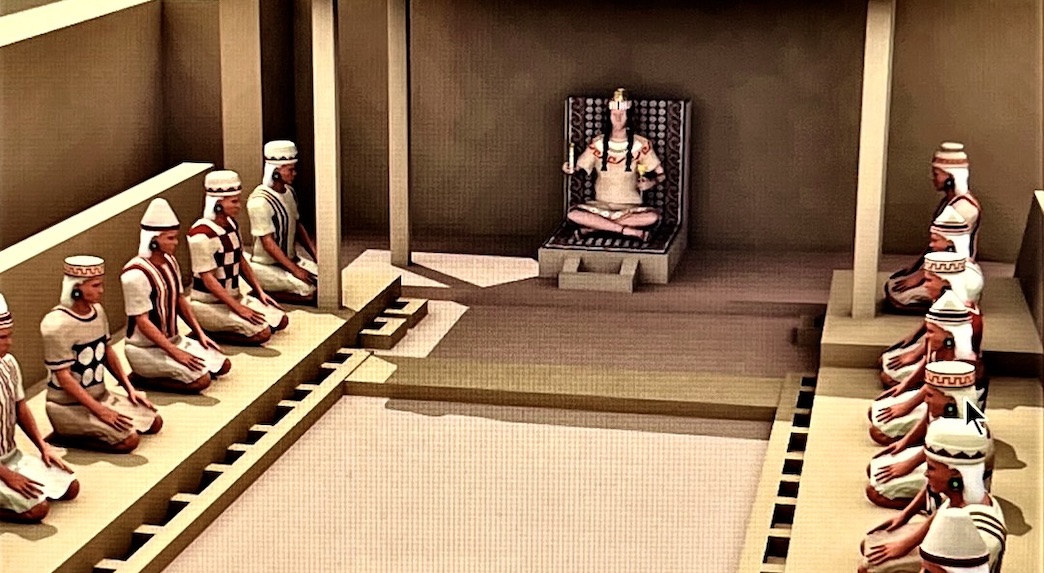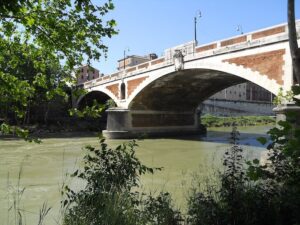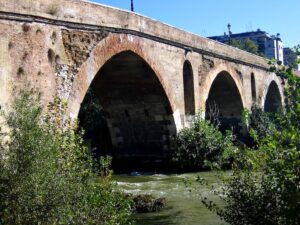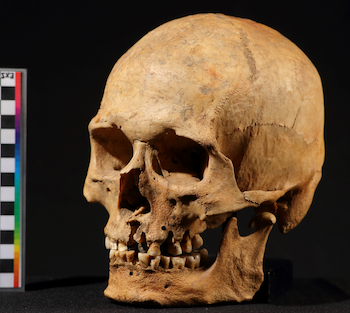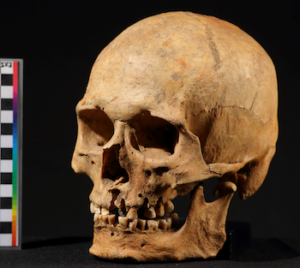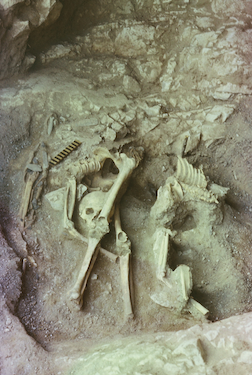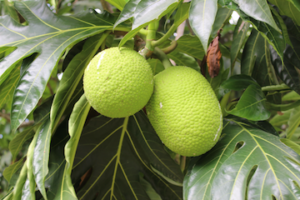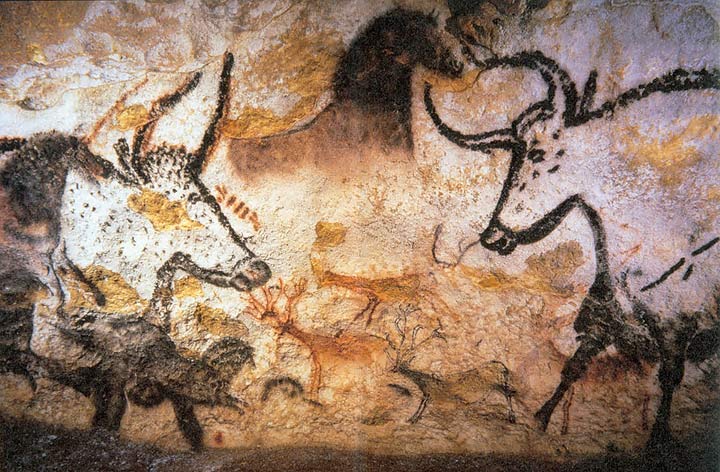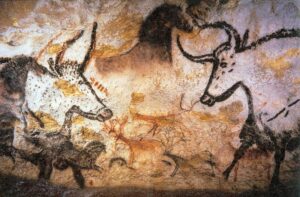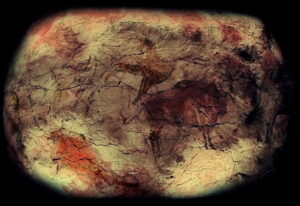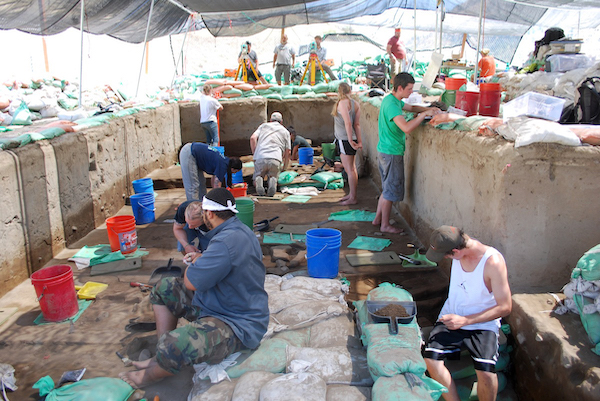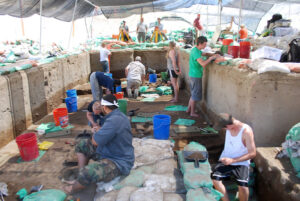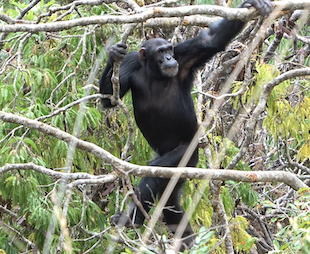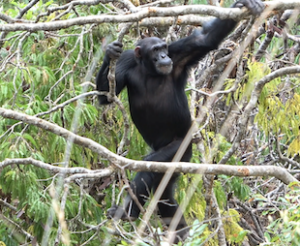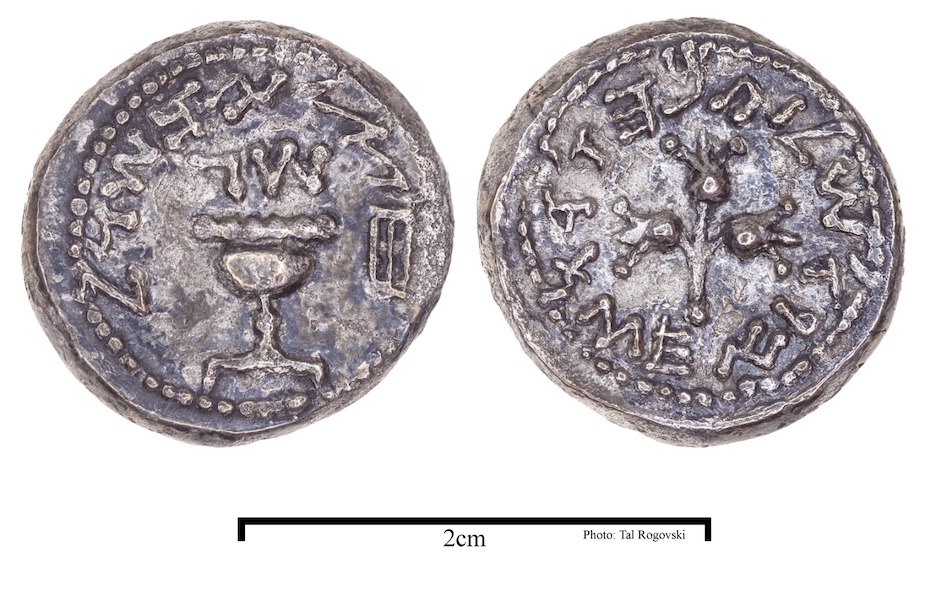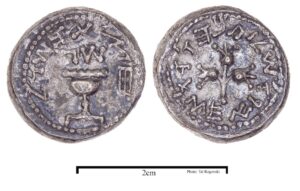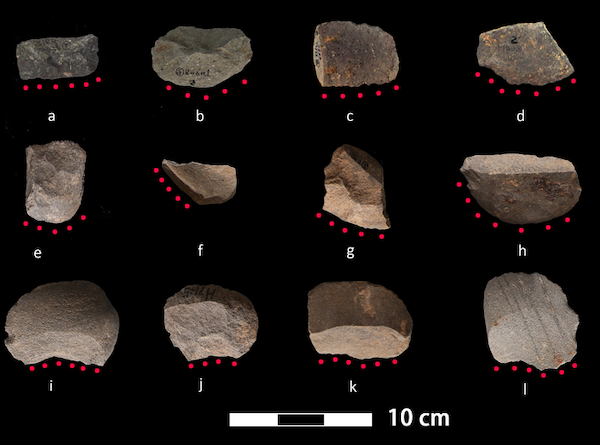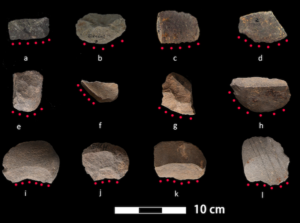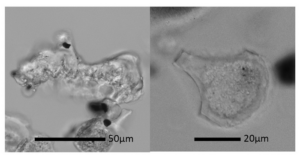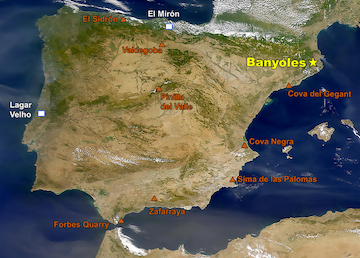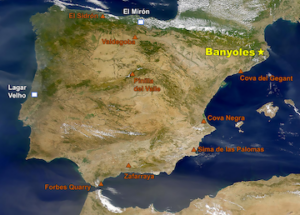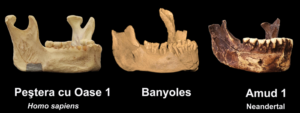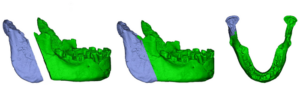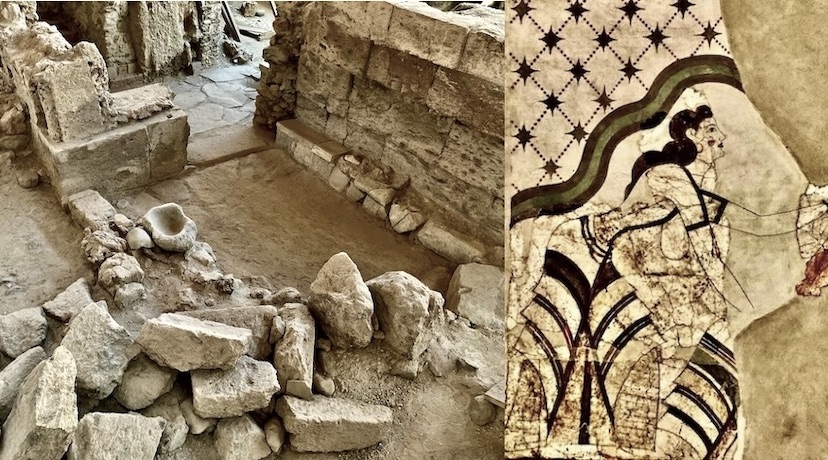
Standing and peering out from here, I could easily see why people the world over flock to this destination. Far below me lay what appeared to be a vast, lustrous blue Mediterranean inlet. In fact, it is a massive, ancient water-filled caldera — the result of multiple past volcanic eruptions. This is what makes Fira, Greece’s sunny, bustling Santorini tourist town, a magnet for Europe’s honeymooners and vacationing couples. Behind me I could hear throngs of them walking the strand that hugs the great caldera’s high ledge. They are here to shop the countless pricey boutiques that line the strand — jewelry, clothing, souvenirs, everything money can buy. Some of them are wearing the clothes they purchased in these shops just yesterday. Many of them, however, are either unaware or uninterested in arguably the most valuable asset this popular resort island has to offer: its past.
Just a short walking distance from where I stood, one of the world’s most prolific collections of ancient Aegean artifacts are displayed. Built in the early 70’s on the site of the earthquake-destroyed Ypapanti Church, the Museum of Prehistoric Thera stands almost unnoticed within a well-appointed gated space. Though almost lost among the commercial bustle that surrounds it, here is housed a time capsule of human habitation and life that flourished as much as over 5,000 years ago.
And even before.
One exhibit near the museum entrance features fossilized flora recorded in the walls of the ancient caldera, echoing a 60,000-year-old ecosystem with a Mediterranean climate not unlike today’s climate on Santorini (known anciently as Thera). Beyond this, the spaces reveal a rich Late Neolithic and Bronze Age history of human occupation, with the most prolific exhibits showcasing the great 17th century BC florescence of the remarkable Minoan civilization that dominated the island at that time. The urban settlement of Akrotiri, the archaeological remains of which Santorini is best known and from which most of the artifacts exhibited in the museum were excavated, represents one of archaeology’s most spectacular discoveries, second only to Italy’s Pompeii and Herculaneum for the wealth and preservation of the material culture ancient people have left behind……….
__________________________________

View of the caldera from modern day Fira on Santorini.
__________________________________

The Museum of Prehistoric Thera
__________________________________
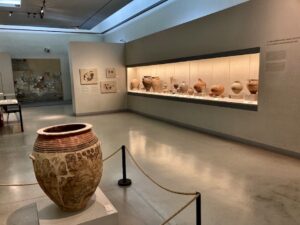
A view of the interior of the Museum of Prehistoric Thera
__________________________________
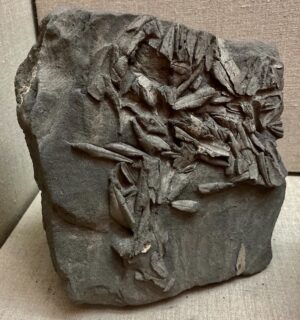
Fossilized leaves of the olive tree from the walls of the caldera, dated to 60,000 BP.
__________________________________
The Wonder of Akrotiri
For the people who went about their routine and peaceful daily lives in the island city of Akrotiri between 1609 and 1560 BCE, signs of the nearby volcano’s coming fury must have been noticeable for days. Earth tremors and tell-tale vapor-like plumes at its summit sounded the alarm, giving them time to quickly gather their most precious and necessary belongings and family members and make their way to the boats. As a maritime society where fishing, an aquatic industry and seagoing trade defined their lives, the technology and resources for evacuation were probably at hand.
Archaeologists can paint such a picture of a society prepared to escape the loss of life characteristic of such a disaster, as excavations of the city’s remains yielded little or no skeletal remains which would evidence a population caught and perished in the great cataclysm that was the eruption of the Thera volcano — one of the largest volcanic events of human history. It is said to have ejected up to four times as much material as the famous eruption of Krakatoa in 1883, destroying all indigenous life on the island. Its effect was experienced across the globe, its plume and volcanic lightning possibly described in the Egyptian Tempest Stele, and the Bamboo Annals of ancient China reporting rare yellow skies and summer frost during the Shang dynasty — clear signs of a volcanic winter.
Though largely abandoned by the time Thera released its first explosive bellow, Akrotiri’s pre-eruption structural face was transformed in the fiery onslaught. Yet, like ancient Rome’s Pompeii and Herculaneum below the pyroclastic expulsion of Mount Vesuvius in 79 AD, Thera’s ejecta and ash produced a remarkable result — an ancient city much destroyed yet miraculously well enough preserved to create a stunningly detailed time capsule of life and advanced human achievement more than 3,500 years old.
Extensive excavations beginning in 1967 by archaeologist Spyridon Marinatos and his team uncovered a remarkably advanced urban settlement, with multi-storied buildings, paved streets, evidence of fine furniture, various religious and domestic vessels, magnificent fresco wall paintings, an elaborate and advanced drainage system, and much more. Like Pompeii and Herculaneum, Akrotiri proved to be one of the most spectacular archaeological sites ever uncovered. Of all the objects and features of the ancient city discovered, however, no other Bronze Age site in the world could compare to Akrotiri in terms of the early advanced works of distinctive fresco painting produced by its master artists — the most prolific collection of such paintings preceding the great fresco works of the masters of ancient Rome and Renaissance Italy much later.
___________________________________
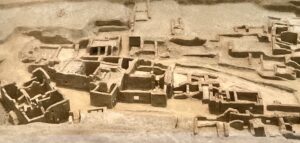
Aerial view of the central area of the Akrotiri excavation site (model as exhibited within the Museum of Prehistoric Thera).
___________________________________

Akrotiri: “Triangle Square”, shows the height at which the structures at Akrotiri were preserved from the volcanic eruption. See below for additional examples of site preservation.
___________________________________
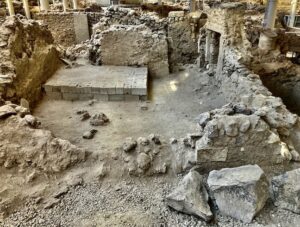
“Millhouse Square”
___________________________________
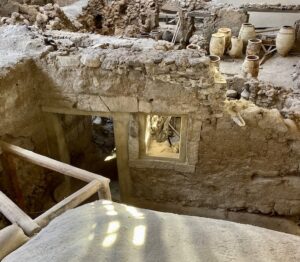
“Pithoi Room”
___________________________________
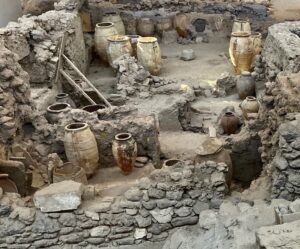
“Pithoi Room”
___________________________________
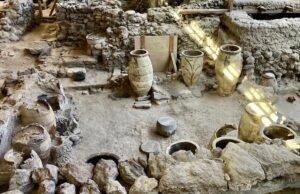
“Pithoi Room”
___________________________________
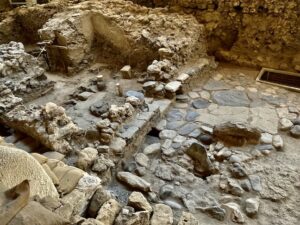
___________________________________
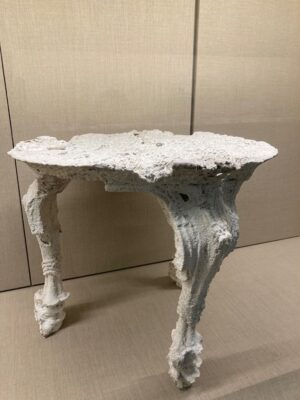
Plaster cast of a carved wooden table.
___________________________________
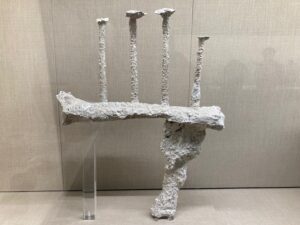
Plaster cast of a portion of a chair.
___________________________________
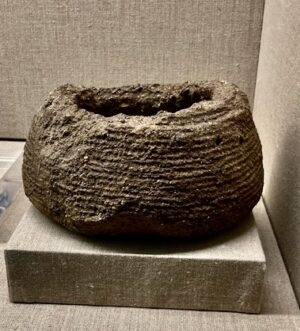
Basket impression
___________________________________

Above and below: Amazingly well preserved furnishings.
___________________________________
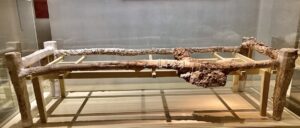
___________________________________
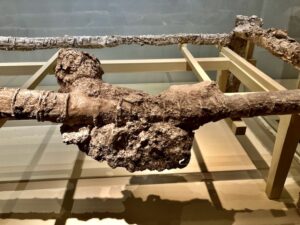
___________________________________
___________________________________
 The Paintings of Akrotiri
The Paintings of Akrotiri
The excavations at Akrotiri have informed a picture of public and religiously significant buildings and other structures adorned with masterfully created fresco paintings that reflected, for this time in ancient history, a unique, avant-garde style. They have marked the Minoans as a standout in this way among ancient populations, particularly during the 17th century BC. Moreover, of all the Minoan settlements that have been excavated, Akrotiri has yielded the best preserved paintings recovered in situ from the walls of its structures……….
Xeste 3
Located south within the excavation area, a large structure (the second largest excavated at Akrotiri) was found to contain the largest assemblage of wall paintings, and is distinct from all other structures in that it housed a lustral basin. In Minoan palaces such as that found at Knossos on Crete, lustral basins were sunken rooms that are thought to have been used either for ritual purification, or as bathrooms. This multi-storey building featured stone benches, a grand staircase, and 15 rooms. The rooms were connected with multiple pier-and-door partitions/doorways that permitted flexibility and adaptability to be interconnected or shut off when necessary. Archaeologists believe, based on the findings, that the building was used for public ceremonies and ritual activity. The rooms as well as the grand staircase were adorned with wall paintings.
______________________________________

Artist rendering of Xeste 3, as presented at the Museum of Prehistoric Thera
______________________________________
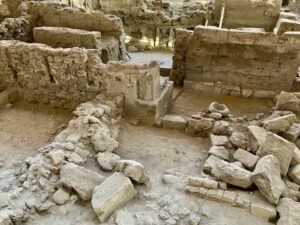
Above and below: Excavated remains of Xeste 3.
__________________________________
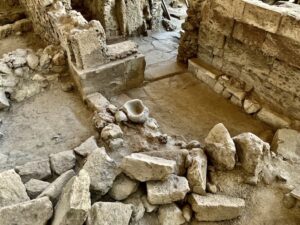
__________________________________
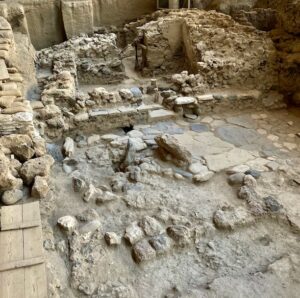
__________________________________
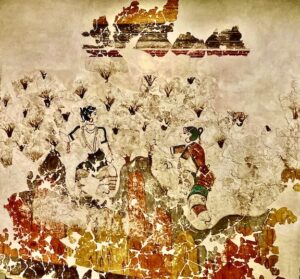
Above and below: Xeste 3, Room 3, 1st Floor: Females gathering crocus flowers, then offering their stigmas to the Godess of Nature through the intervention of a monkey.
__________________________________
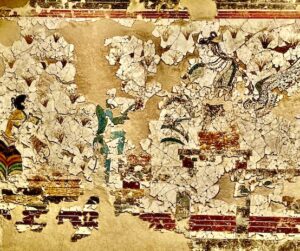
__________________________________
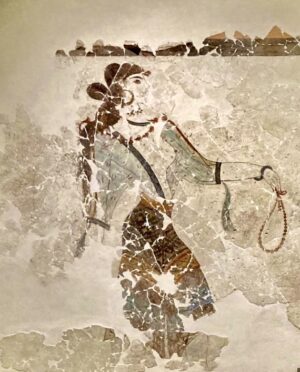
Above and below: Xeste 3, Room 3, Ground Floor: Painted above the Lustral Basin, three females perform a ritual involving crocus plants on the Theran landscape.
__________________________________
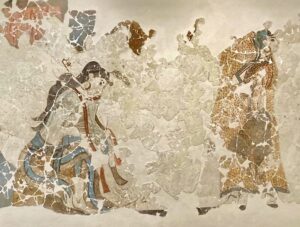
__________________________________
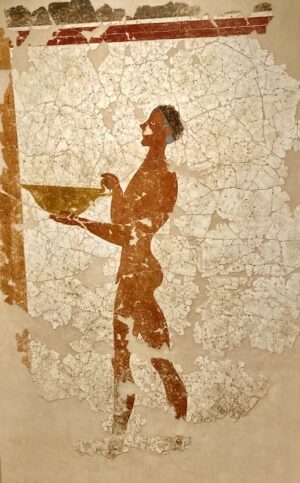
Above and below: Xeste 3, Room 3 Ground Floor: Male figures performing a rite of passage ceremony.
__________________________________
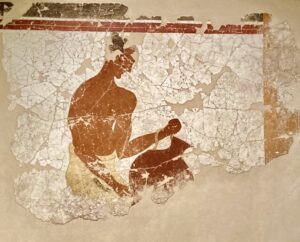
__________________________________
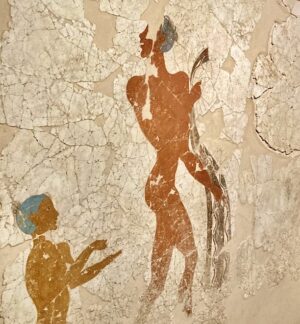
__________________________________
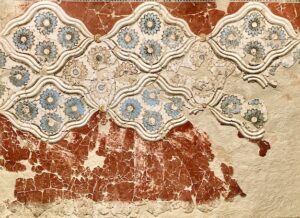
Xeste 3: Wall painting with relief ornaments and painted rosettes: From a room on the second story
__________________________________
The West House
Located in the west central part of the excavation site, the structure designated as the “West House” by archaeologists contained some of the best known, best preserved wall paintings. The house was long and relatively narrow, consisting of a ground floor, first floor, second floor and main staircase that gave access to each storey. The ground floor featured storerooms, workshops, a kitchen and a mill-installation. The first floor had storage rooms, a lavatory, two rooms featuring magnificent mural paintings, and a large chamber dedicated to weaving. The upper floor also contained rooms. The notable wall paintings found in the West House include two frescoes of fishermen, or youth fishers, a fresco of a female holding a vessel, interpreted as a priestess, and a magnificent miniature frieze depicting what is interpreted to be a flotilla, illustrating a major overseas voyage of a fleet visiting several harbors and towns.
____________________________________
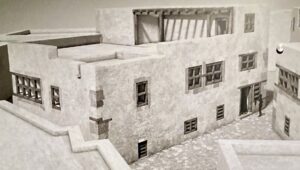
Artist’s conception of the West House, as exhibited at the Museum of Prehistoric Thera.
____________________________________
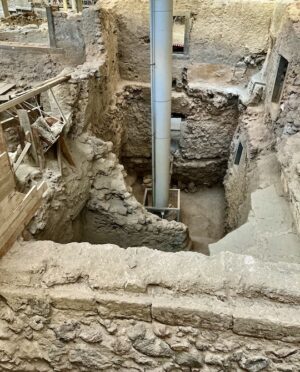
Above and below: Excavated remains of the West House.
_________________________________
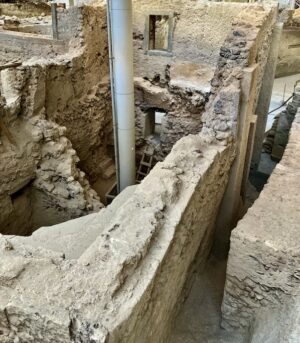
_________________________________
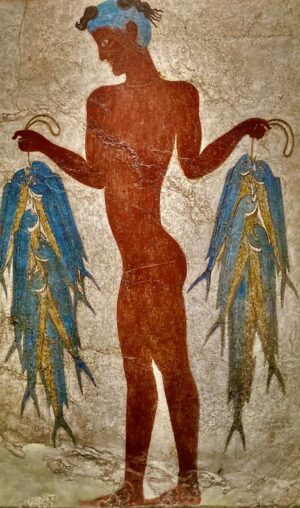
Above and below: Fishers as displayed in West House.
_________________________________

_________________________________
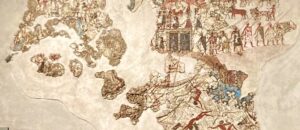
A partial frieze, a portion of which may be illustrating a naval battle.
_________________________________
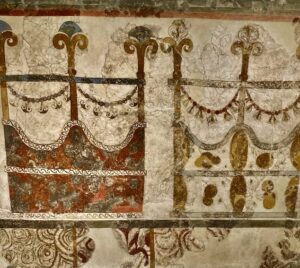
Above and below: Paintings depicting the chambers of a ship.
_________________________________
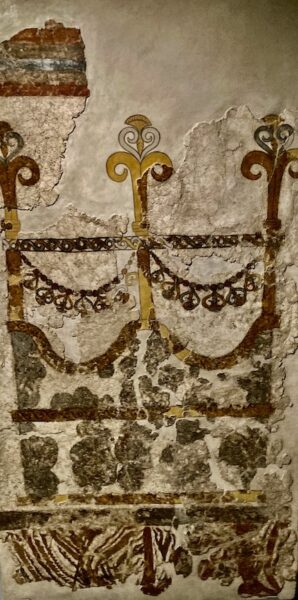
_________________________________

Above and below: Frieze illustrating the adventures and explorations of early Aegean seafarers.
_________________________________

_________________________________
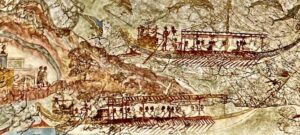
_________________________________
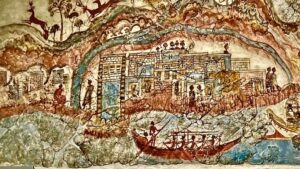
_________________________________
The House of the Ladies
Located in the northwest section of the site, the “House of the Ladies” is a large, multi-storey building thought to be the house of an upper class family. It was named after the wall fresco of the ladies and papyrus plants that decorated the interior of one of the rooms. The structure is thought to have once been a three-storey house with as many as 10 rooms on each floor, but extensive destruction of the north end of the building has created uncertainty.
___________________________________
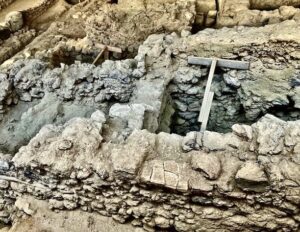
Above and below: Excavated remains of the House of the Ladies
___________________________________
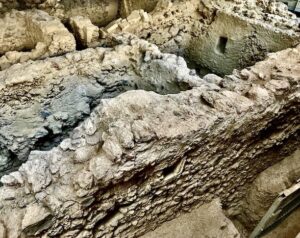
________________________________
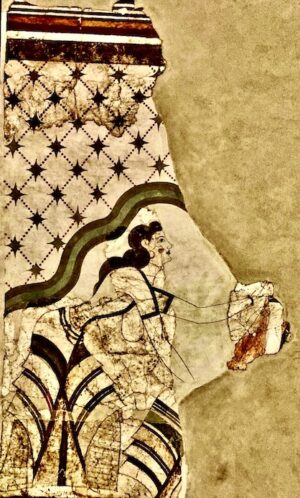
Above and below: The wall paintings from the House of the Ladies.
________________________________
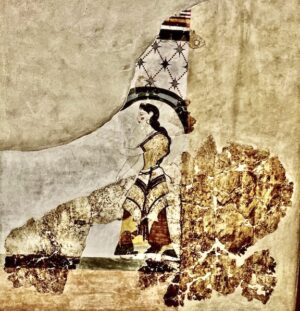
________________________________
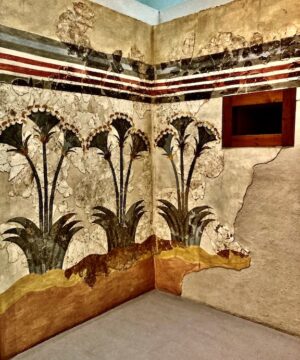
________________________________
Sector Beta
Situated in the south central area of the site, two attached buildings featured three of the most notable frescoes of Akrotiri. The first floor of the western building was adorned with two wall paintings, the Antelopes and the Boxing Boys. The eastern building featured the large, avant-garde composition called “Fresco of the Monkeys”, showing monkeys climbing over a rocky landscape at the side of a river.
____________________________________

____________________________________

_________________________________
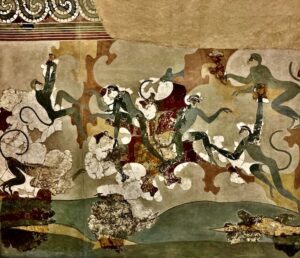
_________________________________
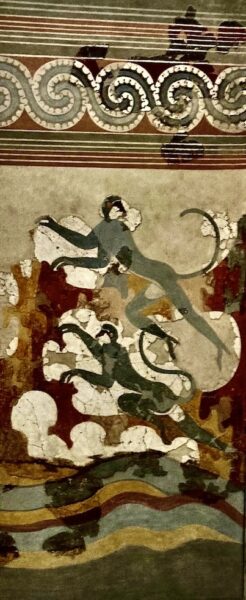
_________________________________
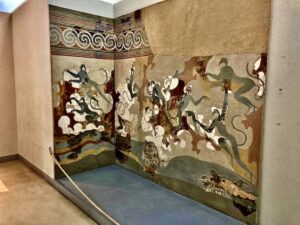
The wall paintings of the monkeys as they would have related in situ in sector B structure room (As displayed in the Museum of Prehistoric Thera).
_________________________________
Complex Delta
Occupying a central position in the city is the Complex Delta, which actually comprises four structures or buildings, each crowned above the entrance with double horns of consecration. Mud flow from the eruption inundated the rooms, yet preserved in situ one of Akrotiri’s most famous artworks, the Spring Fresco, in one of the rooms. Also preserved were imprints of wooden vessels and furniture, seen today as plaster casts. Other finds included tablets of the Linear A script and numerous examples of imported pottery, precious stone and bronze objects.
____________________________________
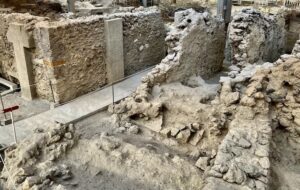
Above and below: Excavated remains of Complex Delta.
____________________________________

_________________________________
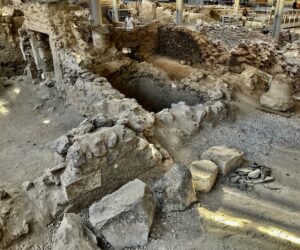
_________________________________
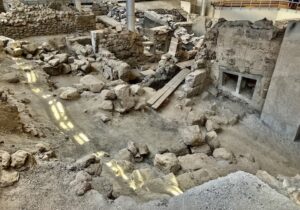
_________________________________
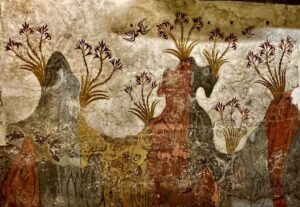
Above: Spring Fresco detail. Below: Spring Fresco in its entirety as exhibited at the National Archaeology Museum of Athens
_________________________________
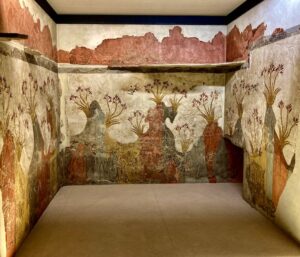
_________________________________
Creating the Art
Much of the style and iconography of the Theran wall paintings were clearly derived from those seen on Crete, where the greater part of Minoan civilization flourished. This included the common tripartite organization of the wall compositions, females represented in white flesh and males in brown, and themes including natural world elements and ritualistic, productive human activity. Although the artists drew from centuries-old Cycladic tradition in art creation, most of the Theran artists trended toward the avant-garde in their representations, a characteristic that set them apart from other artistic traditions and achievements of the time.
As to the process of creating the paintings, the artists applied a mixed technique of buon fresco, applying pigments to wet plaster, and fresco secco, applying pigments to dried plaster.
The paintings were created in four successive phases:
- Wall surfaces were first smoothed with a layer of mixed mortar and straw. Over this, they applied a layer of lime plaster (stucco) about 1 to 2.5 cm thick, then a layer or two of fine stucco.
- While the stucco was still wet, a taught, fine string was stretched/pressed into the stucco to create three horizontal physical divides in the wall composition. Wall paintings on Thera were typically divided into three zones in this way.
- The artist would render a sketching of the subject(s) by incising or light washing the lies into the stucco. This guided the actual painting onto the still-wet stucco/plaster, where the colors were absorbed into the plaster itself. Smaller details were then added often after the stucco had dried.
- The palette of colors used were largely the same as that used by the Minoans on Crete: the background white of the stucco, earth pigments for black, red and yellow from hematite and yellow ochre, and Egyptian blue, imported from Egypt, and/or glaucophane. The painting was then enriched with different tones, including colors such as rose, pale pink, reddish brown, and dark brown. To achieve these variations, the artist combined pigments or mixed them in lime water.
____________________________________
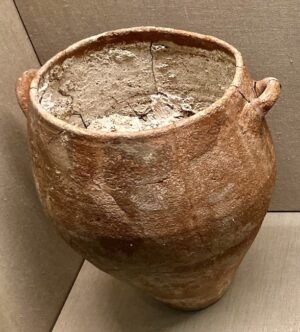
Pithos containing lime-plaster. Above and below artifacts excavated at Akrotiri.
____________________________________
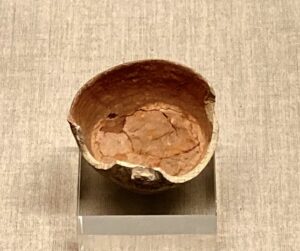
Semiglobular cup containing red pigment
____________________________________
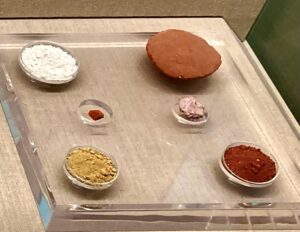
Pigments and lime
____________________________________
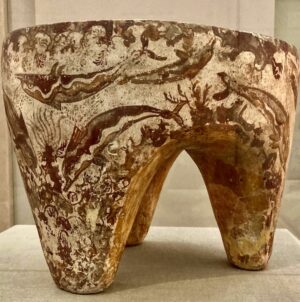
Paintings and painting techniques were not exclusive to walls. Here, for example, is a Minoan offering table excavated at Akrotiri, showing use of painting to illustrate ceramic ware with scenes and subjects from their natural surroundings. Ceramic ware pieces below indicate the same trend or style of painting throughout the culture at Akrotiri.
____________________________________
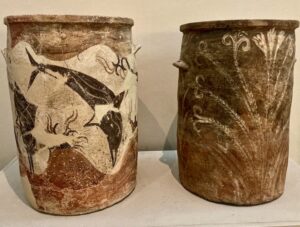
____________________________________

____________________________________
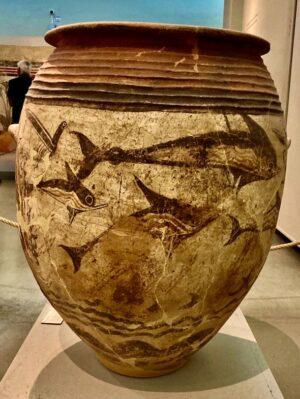
____________________________________
A Theran Diaspora?
Though the distinctive Minoan style of wall painting can be said to be a regional phenomenon (e.g., Thera and Crete), in recent years archaeologists have found evidence of its presence in other parts of the Mediterranean. Were the art masters of Thera known and in employment demand among the palace, temple, and wealthy elites throughout the Bronze Age Old World trade network? Or did the artist refugees of the great Thera eruption find their way to other parts of the known world to ply their trade and perhaps even to settle?
The Canaanite site of Tel Kabri in present-day northwest Israel, for example, could hold clues to answers. The author spoke with the George Washington University’s Dr. Eric H. Cline in Washington, D.C. in May of 2011. Cline had already been co-director of the excavations at Kabri for years at that point.*
“Kabri, which is a Canaanite palace,” said Cline, “has Minoan wall and floor paintings in it…… We already knew about this site because Kabri had been excavated before by [Aharon] Kempinski and [Wolf-Dietrich] Niemeier from 1986 to 1993, and they found a painted floor and about 2,000 fragments of painted plaster.”
There are several things that strongly suggest the paintings were Minoan or Cycladic in style, according to Cline.
“One is this whole technique of painting on the plaster wall while it is still wet,” continues Cline. “That is an Aegean technique. In the Near East, they more often painted after the plaster was dry. Second, there is a technique of using strings to help in the painting process. For example, the Minoans took a string and just tightened it so that it contacted the wet plaster and created a perfectly straight line. We have plaster at Kabri that shows that. The other thing they did was take string and dip it in, for example, red paint, and tighten it quickly against the plaster. The red paint thus makes a perfectly straight line. That is how the floor at Kabri was created. That is a Minoan technique.”
Moreover, the painted subject matter appears to match the subject elements typically depicted in wall paintings such as those found at Akrotiri on Thera and Knossos on Crete, says Cline, such as certain plant and flower types, the ships, and architecture.
Were they works produced by Theran artisans who were displaced by the great Theran eruption? Possibly, says Cline, But he emphasizes that this is purely speculative.
Were they evidence of new, permanent Minoan settlers at Kabri? Possibly, says Cline. But likely not for long. Cline summarizes his view on this question:
“There is no evidence so far that Minoans, or any other Aegean people, such as those in the Cyclades or mainland Greece, migrated to and settled at Kabri as a group. We don’t have enough Minoan pottery to support that. I suspect that, yes, the eruption at Santorini may have caused a migration of people from the island, including artisans who may have painted at Akrotiri or Knossos and were in need of employment, staying at Kabri temporarily. Certainly the paintings at Kabri look an awful lot like the ones on Santorini [ancient Thera]. So it may have been a refugee situation, but that would be mere speculation. The one thing we can support right now is that, if there was a group of Aegean people at Kabri, they were only living there temporarily.”
At least three other places or excavation sites in the eastern Mediterranean have evidenced painting like that found at Akrotiri. One is Tel Dab’a in Egypt, another in Turkey at Alalakh, and finally at Qatna in Syria, currently being excavated by a German/Italian/Syrian team.
Married to the Sea
As I found myself hiking along the edge of Santorini’s great caldera and gazing out and down at ocean water where, anciently in some places dry land existed, I could not help but think about the ancient landscape, and the people who once thrived here over 3600 years ago.
Though the written records of Akrotiri — as they were created on clay tablets in Linear A, a yet undeciphered script — have offered few clues to this ancient society, the artifacts, structures, and paintings revealed by the excavations have provided a rare window on the lives of this ancient people: We know they were advanced in the sense that they lived in multistoried buildings with sophisticated drainage and water distribution systems, indoor bathrooms, lustral basins for ritual practice, and apartments and rooms designed for flexible and adaptable use. Though they practiced agriculture, they were most of all a maritime people, whose economy flourished on extensive trade with other civilizations in and around the Mediterranean, such as Minoan Crete, Mainland Greece, Egypt, Cyprus, and the Levant. Pottery imports and other artifacts, as well as their wall paintings depicting ships, testify to this. This therefore was a people who were enriched through trade. Its position on an island that occupied a strategic position between Cyprus and the Levant to the east, Crete and Egypt to its south, and mainland Greece to its north, made sure of that. Its people wore fine clothing. Artifacts and structures evidenced a well-developed textile industry. The beautifully-clad women appeared to have been revered and, indeed, occupied an important and even elevated position in its culture and religious practices, even in the form of deities. Their culture and way of life was deeply defined by their religion. In addition, they loved and esteemed their natural environment, as clearly demonstrated by their art. Above all, the masterful paintings have given the world an almost intimate and stylistic window on the minds of the Akrotirian inhabitants.
Walking among the remains of Akrotiri, I marveled at how the 3,600-year-old shroud of its volcanic ash and debris was painstakingly removed many years ago by teams of archaeologists and their volunteers. Today the city stands silent and empty, at least the small portion that has been thus far revealed — a shadow of a once bustling community. Only the mind’s eye can now fill these streets with life. But subtle clues in its remains tell us they were a people likely much like us.
Perhaps more than we might imagine.
Advertisement
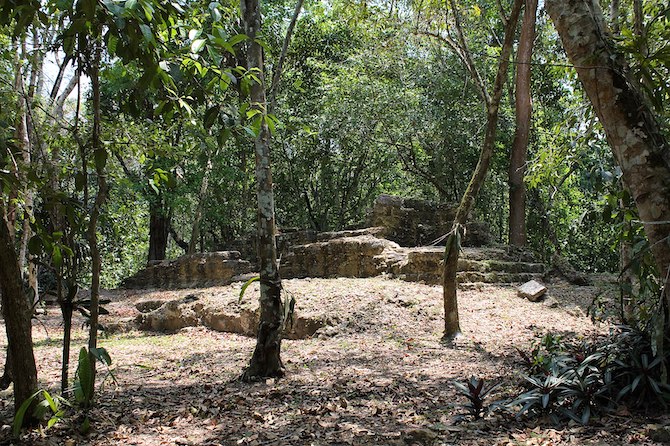
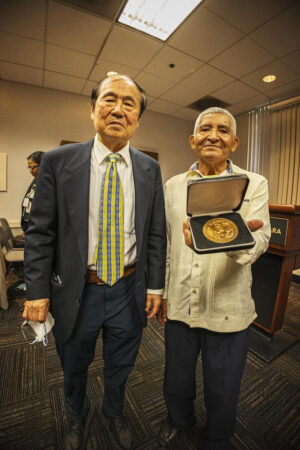
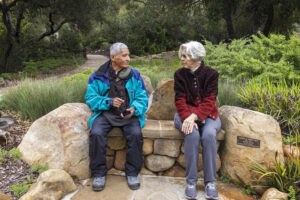
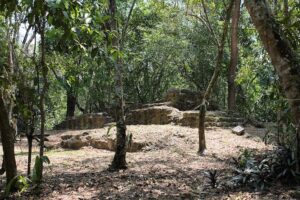

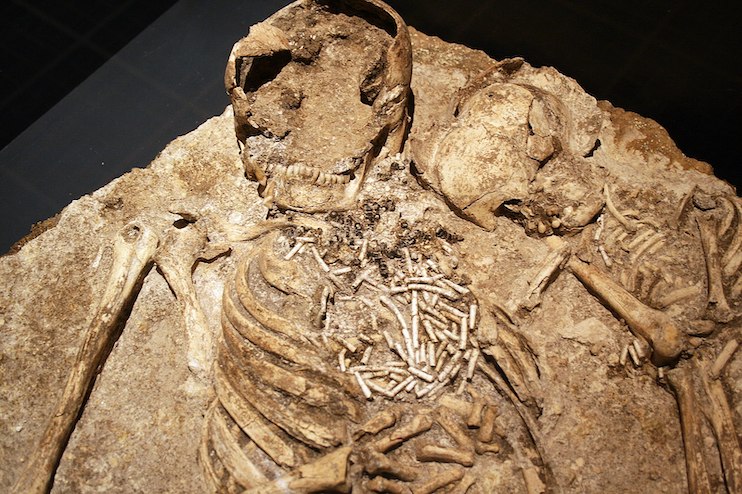
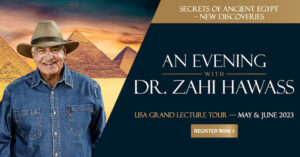
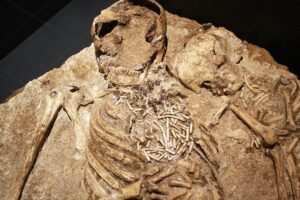

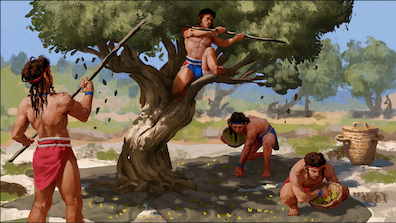
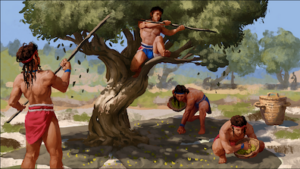
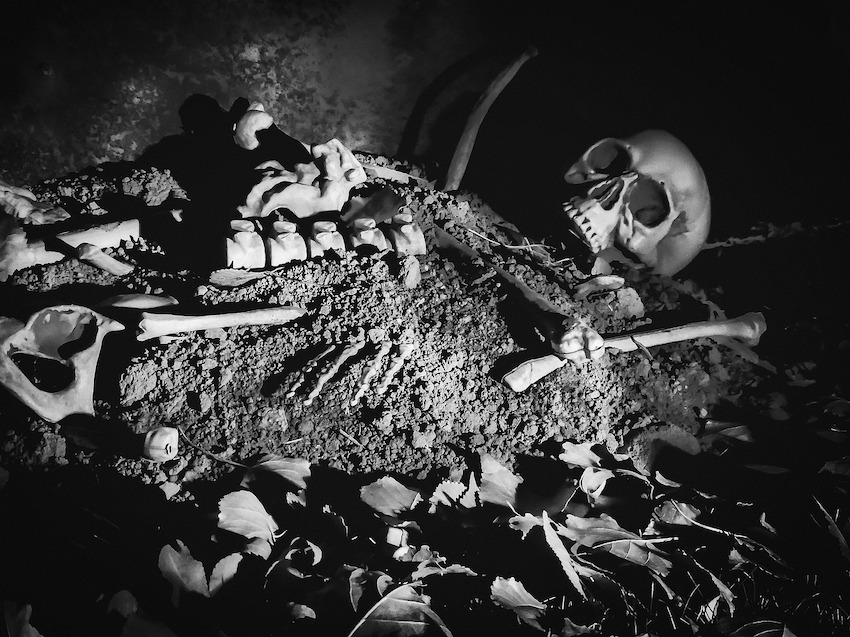
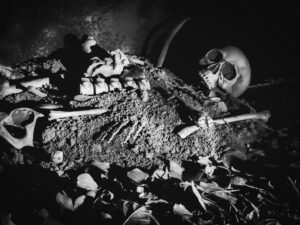


















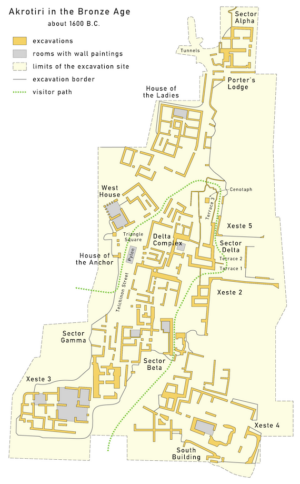
 The Paintings of Akrotiri
The Paintings of Akrotiri














































